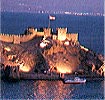![]()
 |
 |
 |
 |
 |
| Ancient Sinai (6000 - 600 BC) | Biblical Sinai (c. 1400 BC) | Classical Sinai (600 BC - 600 AD) | Islamic & Ottoman Sinai (600 - 1900 AD) | Recent History (1900 AD - Present) |
| Humankind's presence in Sinai dates back eight thousand years, when early bronze age settlers arrived in search of valuable metals. They developed the peninsula's copper and turquoise mines, which later drew the attention of Egypt's earliest pharaohs. By 3000 BC Egypt had asserted its control over the region. For the next three millenia, Sinai remained sparsely inhabited, serving primarily as a mining region and as a military route between Egypt and the great civilizations of the Fertile Crescent. | Even as great chariot armies clattered back and forth across its stony expanses, Sinai played host to a quieter but ultimately far more memorable set of events. Around 1400 BC, Moses led the Israelites through its "great and terrible wilderness" on the epic journey recounted in Exodus. Three thousand years later, the sites and the episodes of that journey continue to stand at the very core of the history of Sinai. | As the power of the pharaohs waned and that of the Greeks and Romans waxed, the Sinai was drawn into a new era. In the north, the ancient Track of Horus became a fortified Roman road with its center at the great city of Pelusium, and in the south Christian refugees (fleeing persecution in Egypt) began to build isolated settlements. By 500 AD, the Roman Empire had split, and Sinai fell into the Christian realm of Byzantium. In 565 AD, the Byzantine emperor Justinian expressed his devotion by constructing the Monastery of St. Catherine at the base of Mount Sinai. | With the advent of Islam in the 7th century, the cultural and political landscape changed once again. Pilgrims from Egypt to Mecca prompted the construction of new towns to shelter and protect them. Medieval Europe launched the crusades, and Sinai once again became a thoroughfare for armies, and great fortresses like that on Pharaoh's Island were built. As this period ended, Bedouin tribes from the east arrived and became the de facto rulers of the peninsula's rough terrain. For the next several hundred years they lived relatively undisturbed, establishing migratory territories and cultural traditions that lasted well into our own time. | The story of Sinai in the last half-century is dominated by the conflicts between Egypt and Israel, the latter of which occupied the peninsula between 1967 and 1982. Since Israel's withdrawal in accordance with the Camp David accords, a less militarized Sinai has welcomed ever-growing numbers of visitors from all countries. Its religious and cultural heritage, as well as its spectacular natural environment, have stimulated an era of economic prosperity that is unprecedented in the peninsula's long history. |
Copyright (c) 1997 by interKnowledge. All rights reserved.